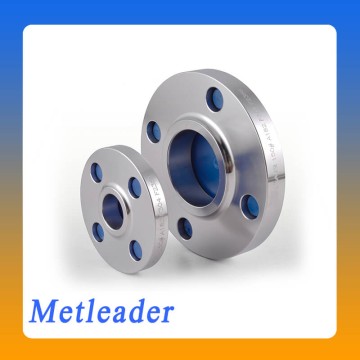ASME B16.5 Slip on Flange
Slip on Flange is an indispensable spare part in pipeline construction. There are many kinds. Materials: forged steel, WCB carbon steel, stainless steel, 304L, 304, 321, 316L, 316, molybdenum titanium, chromium-molybdenum steel, chromium-molybdenum-vanadium steel, rubber lining, fluorine lining materials. The executive standards include ASME B16.5 Slip on Flange, JIS Slip on Flange, DIN Slip on Flange and BS4504 Slip on Flange, etc.

The advantages of flat welding flange are cheap price, convenient construction, easy to save and so on. Large diameter flanges in the form of flat welding flanges, usually with a maximum diameter of 6 meters or more. Widely used in sewage treatment, chemical, municipal, fire, oil, shipbuilding and other fields. Is one of the most used flanges. RF and FF are two types of sealing surface forms of flat-welded flange. RF is a flat-welded flange of face plate type and FF is a flat-welded flange of full-plane plate type. The application amount of FF flat-welded flange is the largest.
Flat welding and butt welding of flat welding flanges are the welding methods when flanges and pipes are connected. When flat welding of flanges, only one side welding is required, and the inner port connecting pipes and flanges is not required. It is suitable for the connection of carbon steel pipes with nominal pressure not exceeding 2.5mpa. Welding installation of butt welding flange requires double-sided welding of flange. Therefore, plain welding flange is generally used for low and medium pressure pipeline, butt welding flange is used for the connection of medium and high pressure pipeline, butt welding flange is generally at least PN2.5Ppa, the use of butt welding is to reduce stress concentration, the general butt welding flange is often with neck flange is also called nipple flange.

Process of ASME B16.5 Slip on Flange
The forging of flat welding flange can be divided into free forging, upsetting, extrusion, die forging, closed die forging and closed upsetting. Closed die forging and closed upsetting forging have high utilization of materials because there is no flanging. It is possible to finish the finishing of complex forgings in one or more processes. Because there is no flanging, the forgings will have less stressed area and the required load will be reduced. However, it should be noted that the blank cannot be completely limited, so that the volume of the blank should be strictly controlled, the relative position of the forging die should be controlled and the forging piece should be measured to reduce the wear of the forging die.
At the beginning of forging deformation of flat welding flange, the preformed blank with holes is easy to deform, the deformation force is small, and the density increases rapidly. In the later stage of forging, due to the closure of most of the pores and the increase of deformation resistance, the deformation force required to eliminate the remaining pores increases rapidly. The deformation resistance is closely related to the deformation temperature. Higher deformation speed is also advantageous for flat welding flange density.
Flat welding flange forging process requires more stringent equipment than traditional die forging, and the displacement characteristics of punch must match the deformation and compactness characteristics of preformed blank. Contact time between blank and mould should be as short as possible. The forging press must have good rigidity, the movable beam and the piston must have the good guidance precision to ensure the forging precision. Therefore, flat welding flange forging generally choose mechanical press, such as crankshaft press, or high precision friction press.

Advantages of ASME B16.5 Slip on Flange
1. Flat welding flange welding device is relatively easy to correct, the device is simple and convenient.
2. Widely used in metallurgy, machinery, chemical industry, petroleum, machine tools, water conservancy, construction engineering, ships, environmental protection, coal and boiler pressure vessels and other occupations.
3. Beautiful appearance, the appearance of flat welding flange is flat and smooth, mainly used for connecting carbon steel pipe.
4. Easy to disassemble and check the pipeline status.
5. Connect the pipeline, flat welding flange can also adhere to the pipeline sealing function.
Disadvantages of ASME B16.5 Slip on Flange
1. Poor rigidity, do not use for damage.
2. Shape features are easier to bump in transit.

Notes for the use of ASME B16.5 Slip on Flange:
1. In order to prevent eyeball corrosion caused by flange cover heating, welding current should not be too large, less than 20% of the carbon steel electrode, arc should not be too long, quick cooling between layers, narrow welding pass is appropriate.
2. Electrode should maintain its dry, when using titanium calcium type should be maintain 150 ℃ dry for 1 hour, low hydrogen type a should keep dry and 200 ~ 250 ℃ for 1 hour, to prevent the covering viscous oil and dirt, and other lest cause weld increased carbon content and affects the quality of weldment.
3. When welding flanged pipe fittings, carbides are precipitated by repeated heating, reducing corrosion resistance and mechanical properties of the products.
4. The hardened American standard flange of chrome flat welding flange fittings is large after welding, which is easy to cause cracks. If using the same type of chromium stainless steel electrode (G202, G207) welding, to be above 300 ℃ preheat and 700 ℃ or so slow cooling after welding. If the welding piece cannot be heat-treated after welding, the welding rod (A107, A207) for flanged pipe fitting shall be selected.
5. Slip on flange, in order to improve the corrosion resistance and weldability, add the appropriate amount of stability elements Ti, Nb, Mo, etc., and the weldability is better than that of chromium flat welding flange. Based on the same type of chromium flat welding flange electrode (G302, G307), should be above 200 ℃ preheat and around 800 ℃ tempering treatment after welding. If the welding piece cannot be heat-treated, the welding rod (A107, A207) for flanged pipe fitting shall be selected.







